Papers by Juan-manuel Sancho
Frontiers in Immunology, Jul 12, 2022
months, respectively, p = 0.027) and OS (58% versus 42% at 12 months, respectively, p = 0.048) th... more months, respectively, p = 0.027) and OS (58% versus 42% at 12 months, respectively, p = 0.048) than tisa-cel. These differences were maintained in the multivariable analysis. On the other hand, axi-cel was independently associated with a higher risk of severe cytokine release syndrome and neurotoxicity. Our results suggest that the efficacy of CART cell therapy is superior to pSOC in the real-world setting. Furthermore, axi-cel could be superior in efficacy to tisa-cel, although more toxic, in this group of refractory patients according to SCHOLAR-1 criteria.

Hematological Oncology, Jun 1, 2017
Introduction: Intravenous (IV) rituximab plus chemotherapy is standard treatment for diffuse larg... more Introduction: Intravenous (IV) rituximab plus chemotherapy is standard treatment for diffuse large B-cell lymphoma (DLBCL). A subcutaneous (SC) formulation of rituximab may simplify treatment and reduce burden. MabEase (NCT01649856) studied efficacy, safety and patient (pt) satisfaction with rituximab SC or IV plus cyclophosphamide, vincristine, doxorubicin and prednisolone (CHOP) as first-line DLBCL treatment. Methods: Pts were randomised 2:1 to rituximab SC (IV 375 mg/m 2 cycle 1; SC 1400 mg cycles 2-8) or IV (375 mg/m 2 cycles 1-8) plus CHOP every 14 or 21 days. The primary end point was investigatorassessed complete response (CR)/unconfirmed CR (CRu) at the end of induction (EOI). Secondary end points included safety, survival, treatment satisfaction (Cancer Treatment Satisfaction Questionnaire [CTSQ], Rituximab Administration Satisfaction Questionnaire [RASQ]) and time savings. Follow-up continued until at least 24 months after EOI in the last patient recruited. Results: Of 576 pts (381 SC; 195 IV), 572 (378 SC; 194 IV) received treatment. EOI CR/CRu rates were 50.6% (95% CI 45.3-55.9) and 42.4 (95% CI 35.1-49.7) in the SC and IV groups, respectively (Table). After 35 months' median follow-up, median progression-free survival (PFS), event-free survival (EFS) and overall survival (OS) were not reached in either arm, and no statistically significant differences were observed between treatment arms. PFS, EFS and OS rates were also similar at 24 months' follow-up (non-significant differences; Table). Grade ≥3 adverse events (58.3% SC; 54.3% IV) and administration-related reactions (21% in both groups) were similar between arms. Of SC recipients, 5.7% had injection site reactions vs none in the IV group (p < 0.001). Febrile neutropenia occurred more often in the SC arm (12.5% vs 6.9% in IV, p = 0.06). RASQ scores for 'impact on activities of daily living', 'convenience' and 'satisfaction' were improved with SC vs IV; CTSQ scores were similar between arms (Figure). When pts in the SC group were asked, if given the option, which treatment they would prefer, 90.8% stated a preference for SC over IV. Median administration time (6 minutes SC vs 2.6-3.0 hours IV) and chair/ bed and overall hospital times were shorter with SC than with IV treatment. Conclusions: Rituximab SC had similar efficacy and safety to the IV form, with improvements in pt satisfaction ratings, and administration/hospital time savings. Our findings support the use of rituximab SC in this setting.
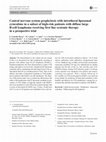
Annals of Hematology, Mar 30, 2016
The dissemination in the central nervous system (CNS) is an uncommon but fatal complication occur... more The dissemination in the central nervous system (CNS) is an uncommon but fatal complication occurring in patients with diffuse large B-cell lymphoma (DLBCL). Standard prophylaxis has been demonstrated to reduce CNS relapse and improve survival rates. Intrathecal (IT) liposomal cytarabine allows maintaining elevated drug levels in the cerebrospinal fluid for an extended period of time. Data on the efficacy and safety of liposomal cytarabine as CNS prophylaxis in patients with DLBCL are still insufficient. The objective of the present study was to evaluate the effectiveness and safety of the prophylaxis with IT liposomal cytarabine in prevention of CNS relapse in high-risk patients with DLBCL who were included in a trial of first line systemic therapy with 6 cycles of dose-dense R-CHOP every 14 days. Twenty-four (18.6 %) out of 129 patients were identified to have risk factors for CNS involvement, defined as follows: >30 % bone marrow infiltration, testes infiltration, retroperitoneal mass ≥10 cm, Waldeyer ring, or bulky cervical nodes involvement. Liposomal cytarabine (50 mg) was administered by lumbar puncture the first day of the 1st, 2nd, and 6th cycle of R-CHOP14 scheme. Among 70 IT infusions, grade 3-4 adverse events reported were headache (one patient) and nausea/ vomiting (one patient). With a median follow-up of 40.1 months, no CNS involvement by DLBCL was observed in any patient. In conclusion, IT liposomal cytarabine is safe, feasible, and effective for CNS prophylaxis, causing few associated risks and little discomfort to patients with DLBCL.
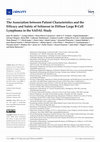
Cancers, 2022
Selinexor, an oral selective inhibitor of nuclear export, was evaluated in the Phase 2b SADAL stu... more Selinexor, an oral selective inhibitor of nuclear export, was evaluated in the Phase 2b SADAL study in patients with diffuse large B-cell lymphoma (DLBCL) who previously received two to five prior systemic regimens. In post hoc analyses, we analyzed several categories of patient characteristics (age, renal function, DLBCL subtype, absolute lymphocyte count, transplant status, number of prior lines of therapy, refractory status, Ann Arbor disease stage, and lactate dehydrogenase) at baseline, i.e., during screening procedures, to determine their potential contributions to the efficacy (overall response rate [ORR], duration of response [DOR], overall survival [OS]) and tolerability of selinexor. Across most categories of characteristics, no significant difference was observed in ORR or DOR. OS was significantly longer for patients < 65 vs. ≥ 65 years, and for those with lymphocyte counts ≥ 1000/µL vs. < 1000/µL or lactate dehydrogenase ≤ ULN vs. > ULN. The most common adverse...

Clinical Lymphoma Myeloma and Leukemia, 2021
Patients with relapsed and refractory diffuse large B-cell lymphoma (DLBCL) have a poor prognosis... more Patients with relapsed and refractory diffuse large B-cell lymphoma (DLBCL) have a poor prognosis and a median overall survival of less than 6 months. Outcomes and responses were evaluated in 134 patients with DLBCL administered selinexor. Our findings demonstrate that selinexor treatment in DLBCL patients can safely induce durable responses and improve outcomes regardless of prior treatments and refractory status. Background: Despite a number of treatment options, patients with diffuse large B-cell lymphoma (DLBCL) whose disease has become refractory to treatment have a poor prognosis. Selinexor is a novel, oral drug that is approved to treat patients with relapsed/refractory DLBCL. In this post hoc analysis of the SADAL study, a multinational, open-label study, we evaluated subpopulations to determine if response to single agent selinexor is impacted by number of lines of prior treatment, autologous stem cell transplant (ASCT), response to first and most recent therapies, and time to progressive disease.Patients: Patients (n = 134) with DLBCL after 2-5 prior therapies were enrolled in SADAL and received 60mg selinexor twice weekly. Results: The median overall survival was 9.0 months and median progression free survival was 2.6 months. Patients who had the best overall response rate (ORR) and disease control rate were those who had prior ASCT (42.5% and 50.0%) or responded to last line of therapy (35.9% and 43.5%). Patients with primary refractory DLBCL also showed responses (ORR 21.8%). Adverse events between subgroups were similar to the overall study population, the most common being thrombocytopenia (29.1%), fatigue (7.5%), and nausea (6.0%). Conclusion:
Hematological Oncology, 2021
Céligny, Roy et al. 2004), where male (M) gender has been included as a prognostic factor in some... more Céligny, Roy et al. 2004), where male (M) gender has been included as a prognostic factor in some of the prognostic indices. Moreover, large cohorts of diffuse large B cell lymphoma (DLBCL) show that female (F)

Journal of Hematology & Oncology, 2021
Patients with RR DLBCL who have received ≥ 2 lines of therapy have limited treatment options and ... more Patients with RR DLBCL who have received ≥ 2 lines of therapy have limited treatment options and an expected overall survival (OS) of < 6 months. The SADAL study evaluated single-agent oral selinexor in patients with RR DLBCL and demonstrated an overall response rate (ORR) of 29.1% with median duration of response (DOR) of 9.3 months. The analyses described here evaluated a number of subpopulations in order to understand how response correlates with survival outcomes in order to identify patients who could most optimally benefit from selinexor treatment. Median age was 67 years; 44.8% of patients were ≥ 70 years of age. The median OS was 9.0 months (95% CI 6.2, 13.7) at a median follow-up of 14.8 months. The median OS was not reached in patients with a CR or PR, while patients who did not respond have a median OS of 4.9 months (p < 0.0001). Patients < 70 years had an OS of 11.1 months compared with 7.8 months in patients ≥ 70 years. Among patients with or without prior ASCT...
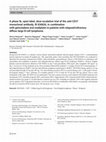
Investigational New Drugs, 2021
SummaryBackground BI 836826 is a chimeric mouse–human monoclonal antibody directed against human ... more SummaryBackground BI 836826 is a chimeric mouse–human monoclonal antibody directed against human CD37, a transmembrane protein expressed on mature B lymphocytes. This open-label, phase I dose-escalation trial (NCT02624492) was conducted to determine the maximum tolerated dose (MTD), safety/tolerability, and preliminary efficacy of BI 836826 in combination with gemcitabine and oxaliplatin in patients with relapsed/refractory diffuse large B-cell lymphoma (DLBCL). Methods Eligible patients received intravenous infusions of BI 836826 on day 8 and gemcitabine 1000 mg/m2 plus oxaliplatin 100 mg/m2 on day 1, for up to six 14-day treatment cycles. Dose escalation followed the standard 3 + 3 design. Results Of 21 treated patients, 17 had relapsed/refractory DLBCL and four had follicular lymphoma transformed to DLBCL. BI 836826 dosing started at 25 mg and proceeded through 50 mg and 100 mg. Two dose-limiting toxicities (DLTs) occurred during cycle 1, both grade 4 thrombocytopenia lasting >...
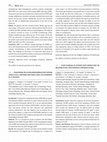
Hematological Oncology, 2021
The primary outcome was freedom from treatment failure (FFTF) post salvage radiotherapy. Secondar... more The primary outcome was freedom from treatment failure (FFTF) post salvage radiotherapy. Secondary outcomes included local control and overall survival post salvage radiotherapy. Survival was calculated from the date of radiotherapy commencement to the date of last follow-up. Results: 46 patients met the inclusion criteria. Median age was 68 years (range, 19-86 years). Just over half the patients had IPI score of ≥3 (51%) and 80% had bulky disease at initial diagnosis. The majority of patients received 6x cycles of R-CHOP chemotherapy (61%). Median radiotherapy dose delivered was 40 Gy (range, 30-46 Gy). FFTF was achieved in 27 patients (59%) with a median follow-up of 54 months. Local control rate and 3-year overall survival post salvage EBRT were 80% and 59%, respectively. Conclusion: EBRT is an effective salvage technique for DLBCL patients with localised persistent or recurrent PET positive disease post systemic chemotherapy, if safely encompassable by radiotherapy fields. The challenge for the future is to determine which group of patients have micrometastatic disease at conclusion of chemotherapy as current functional imaging is insufficient.
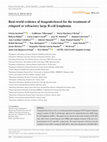
Cancer Medicine, 2021
Tisagenlecleucel (tisa‐cel) is a second‐generation autologous CD19‐targeted chimeric antigen rece... more Tisagenlecleucel (tisa‐cel) is a second‐generation autologous CD19‐targeted chimeric antigen receptor (CAR) T‐cell therapy approved for relapsed/refractory (R/R) large B‐cell lymphoma (LBCL). The approval was based on the results of phase II JULIET trial, with a best overall response rate (ORR) and complete response (CR) rate in infused patients of 52% and 40%, respectively. We report outcomes with tisa‐cel in the standard‐of‐care (SOC) setting for R/R LBCL. Data from all patients with R/R LBCL who underwent leukapheresis from December 2018 until June 2020 with the intent to receive SOC tisa‐cel were retrospectively collected at 10 Spanish institutions. Toxicities were graded according to ASTCT criteria and responses were assessed as per Lugano 2014 classification. Of 91 patients who underwent leukapheresis, 75 (82%) received tisa‐cel therapy. Grade 3 or higher cytokine release syndrome and neurotoxicity occurred in 5% and 1%, respectively; non‐relapse mortality was 4%. Among the in...
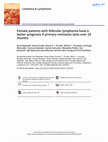
Leukemia & Lymphoma, 2021
Findings regarding the role of sex in follicular lymphoma (FL) are contradictory and the prognost... more Findings regarding the role of sex in follicular lymphoma (FL) are contradictory and the prognostic value of sex among patients with early progression of disease (POD) remains unclear. We collected real-life data from nine hospitals in Finland and Spain including 1020 FL patients to study the influence of sex on disease outcome. The median follow-up duration was 67 months (range 0-226 months). Female patients showed better progression-free survival (PFS) (hazard ratio [HR], 0.720; 95% confidence interval [CI], 0.588-0.881), disease-specific survival (DSS) (HR, 0.653; 95% CI, 0.448-0.951), and overall survival (OS) (HR, 0.653; 95% CI, 0.501-0.853) than male patients. However, there were no significant sex differences in prognosis in patients with early POD. This study strengthens the understanding that male sex is an adverse prognostic factor for FL. However, this difference does not apply to patients with early POD.
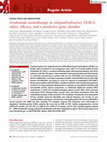
Blood, 2020
Treatment options for relapsed/refractory (R/R) diffuse large B-cell lymphoma (DLBCL) are limited... more Treatment options for relapsed/refractory (R/R) diffuse large B-cell lymphoma (DLBCL) are limited, with no standard of care; prognosis is poor, with 4- to 6-month median survival. Avadomide (CC-122) is a cereblon-modulating agent with immunomodulatory and direct antitumor activities. This phase 1 dose-expansion study assessed safety and clinical activity of avadomide monotherapy in patients with de novo R/R DLBCL and transformed lymphoma. Additionally, a novel gene expression classifier, which identifies tumors with a high immune cell infiltration, was shown to enrich for response to avadomide in R/R DLBCL. Ninety-seven patients with R/R DLBCL, including 12 patients with transformed lymphoma, received 3 to 5 mg avadomide administered on continuous or intermittent schedules until unacceptable toxicity, disease progression, or withdrawal. Eighty-two patients (85%) experienced ≥1 grade 3/4 treatment-emergent adverse events (AEs), most commonly neutropenia (51%), infections (24%), anemi...

European Journal of Haematology, 2019
ObjectivesDiffuse large B‐cell lymphoma (DLBCL) is an aggressive heterogeneous lymphoma with stan... more ObjectivesDiffuse large B‐cell lymphoma (DLBCL) is an aggressive heterogeneous lymphoma with standard treatment. However, 30%‐40% of patients still fail, so we should know which patients are candidates for alternative therapies. IPI is the main prognostic score but, in the rituximab era, it cannot identify a very high‐risk (HR) subset. The MD Anderson Cancer Center reported a score in the prerituximab era exclusively considering tumor‐related variables: Tumor Score (TS). We aim to validate TS in the rituximab era and to analyze its current potential role.MethodsFrom GELTAMO DLBCL registry, we selected those patients homogeneously treated with R‐CHOP (n = 1327).ResultsFive‐years PFS and OS were 62% and 74%. All variables retained an independent prognostic role in the revised TS (R‐TS), identifying four different risk groups, with 5‐years PFS of 86%, 71%, 50%, and very HR (28%). With a further categorization of three variables of the original TS (Ann Arbor Stage, LDH and B2M), we gene...

Blood, 2016
Background and objective. Anthracycline-induced cardiotoxicity is a major issue in the treatment ... more Background and objective. Anthracycline-induced cardiotoxicity is a major issue in the treatment of elderly patients with diffuse large B-cell lymphoma (DLBCL). The use of non pegylated liposomal doxorubicin (Myocet®)has been associated with less cardiotoxicity as compared to conventional doxorubicin in breast cancer, but its benefit in DLBCL has been investigated mostly in retrospective and single-arm prospective studies. The objective of this study was to evaluate the benefit, in terms of cardiac toxicity, of the substitution of conventional doxorubicin as part of R-CHOP therapy by the non pegylated liposomal doxorubicin (Myocet®, R-COMP arm) in older patients (≥60 years) with de novo DLBCL or grade 3b follicular lymphoma (FL). Methods. This is a prospective randomized phase 2 trial (ClinicalTrials.gov Identifier: NCT02012088) of newly diagnosed patients with DLBCL or grade 3b FL ≥60 years old with baseline left ventricular ejection fraction (LVEF) > 55%. Patients were randomiz...
Cancer Medicine, 2019
This is an open access article under the terms of the Creative Commons Attribution License, which... more This is an open access article under the terms of the Creative Commons Attribution License, which permits use, distribution and reproduction in any medium, provided the original work is properly cited.
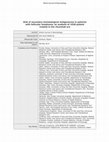
British Journal of Haematology, 2019
SummaryFollicular lymphoma (FL) is the most common indolent lymphoma. Currently there are many co... more SummaryFollicular lymphoma (FL) is the most common indolent lymphoma. Currently there are many comparable treatment options available for FL. When selecting the most optimal therapy it is important to consider possible late effects of the treatment as well as survival. Secondary haematological malignancy (SHM) is a severe late effect of treatments, but the incidence of SHMs is still largely unknown. The goal of the present study was to determine the incidence of SHMs and how therapeutic decisions interfere with this risk. The study included 1028 FL patients with a median follow‐up time of 5·6 years. The 5‐year risk of SHM was 1·1% and the risk was associated with multiple lines of treatment (P = 0·016). The 5‐year risk of SHM was 0·5% after the first‐line treatment and 1·6% after the second‐line. The standardized incidence ratio (SIR) was 6·2 (95% confidence interval 3·4–10·5) for SHM overall. This retrospective study found that the risk of SHM was low after first‐line treatment in ...

Hematological Oncology, 2019
Background: Despite recent advances, follicular lymphoma (FL) remains incurable for most patients... more Background: Despite recent advances, follicular lymphoma (FL) remains incurable for most patients (pts). Relapsed/refractory (r/r) FL is associated with decremental treatment responses, accumulating toxicity, and poor survival among early failures of 1st line chemoimmunotherapy. Underscored by the recent approvals of idelalisib, copanlisib, and duvelisib, targeting B-cell receptor (BCR) signaling produces ORR of~50% in r/r pts; however, new agents with a better therapeutic index over long-term administration are needed. SYK is a key regulator of BCR signaling (upstream of BTK and PI3K), and its inhibition results in clinical activity in FL. Compared with unaffected nodes, lymph nodes from FL pts have greater numbers of follicular helper T cells that express high levels of IL-4, which may support the tumor via the JAK1/3 pathway. Cerdulatinib, an oral, reversible inhibitor of SYK and JAK kinases (JAK1, JAK3, TYK2), previously reported a~45% ORR in r/r FL as a single agent. Xenograft studies suggest cerdulatinib may combine with rituximab to enhance antitumor activity. We report updated results from a Ph2a study of single-agent cerdulatinib and initial results in combination with rituximab in r/r FL. Methods: This Ph2a study confirmed the safety and efficacy of cerdulatinib 30 mg BID in r/r Band T-cell lymphoma pts. Dose reductions were permitted to 15 mg BID. Response was assessed by Lugano criteria. Results: As of Jan 2019, enrollment was 40 pts in the single-agent cohort and 11 in the rituximab combination cohort. Median (range) age was 64 (42-81) and median prior therapies was 3 (1-8). Fifty (98%) pts had prior anti-CD20 therapy, and 8 (16%) had prior PI3K or BTK inhibitors. The most common AEs of any grade were diarrhea (47%), nausea (37%), lipase increase (29%), and amylase increase (22%). Grade 3+ AEs in ≥5% pts were lipase increase (24%), diarrhea (12%), amylase increase (10%), nausea (8%), hypertension (8%), and neutropenia (6%). Grade 3+ infections occurred in 6 (12%) pts. One pt had grade 5 multi-organ failure potentially related to study drug. Amylase and lipase increases generally were not associated with abdominal pain or pancreatitis. The safety profile appeared similar in both cohorts. The ORR was 46% as a single agent (5 CRs, 13 PRs in 40 pts) and 67% in the combination cohort (4/6 PRs; 2 pts with SD had a >40% reduction in tumor volume at 1st re-scan). Responses typically occurred after 2 cycles and were durable in the single-agent cohort, with 10 pts on drug for >1 year. Enrollment in the combination cohort is ongoing. Updated safety and efficacy will be presented. Conclusion: The recommended cerdulatinib Ph2 dose of 30 mg BID was tolerable and efficacious in heavily pretreated r/r FL. The cerdulatinib + rituximab combination appears to be well tolerated, with tumor reductions in all evaluable pts. The safety profile and unique MOA of cerdulatinib support further combination studies in FL.
Hematological Oncology, 2019
positive PD-L1 expression PFS was 100%, but in group with negative PD-L1 expression the median of... more positive PD-L1 expression PFS was 100%, but in group with negative PD-L1 expression the median of PFS was 13 months (Log-rank test, p=0.6) Conclusion: We did not find any significantly associations between PD-L1 and PD1 receptors expression on tumor cells and other known clinical and immunohistochemical parameters in patients with DLBCL as also as PFS. Maybe it is result of small sample of patients included in analysis. Further research work can show final conclusions.
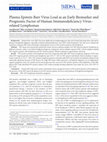
Clinical infectious diseases : an official publication of the Infectious Diseases Society of America, Jan 29, 2018
Epstein-Barr virus (EBV) has been implicated in lymphomagenesis and can be found infecting tumor ... more Epstein-Barr virus (EBV) has been implicated in lymphomagenesis and can be found infecting tumor cells and in plasma at lymphoma diagnosis, especially in HIV-infected patients. Our aim was to evaluate the usefulness of plasma EBV-load as biomarker and prognostic factor in HIV-related lymphomas. EBV-load was measured by polymerase chain reaction (PCR) in plasma samples of 81 HIV-related lymphomas at different moments: within one year before lymphoma diagnosis, at diagnosis and at complete response (CR). Control samples included HIV-negative patients with lymphoma and HIV-infected patients without neoplasia or opportunistic infections. Patients with HIV-related lymphoma had more frequently detectable EBV-load at lymphoma diagnosis (53%) than both, HIV-negative with the same lymphoma type (16%) (p<0.001) and HIV-infected individuals without neoplasia or opportunistic infection (1,2%) (p<0.001). HIV-related lymphoma patients with detectable EBV-load in plasma at lymphoma diagnosis...
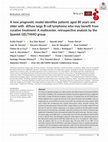
American journal of hematology, Jan 15, 2018
The means of optimally managing very elderly patients with diffuse large B-cell lymphoma (DLBCL) ... more The means of optimally managing very elderly patients with diffuse large B-cell lymphoma (DLBCL) has not been established. We retrospectively analyzed 252 patients aged 80-100 years, diagnosed with DLBCL or grade 3B follicular lymphoma, treated in 19 hospitals from the GELTAMO group. Primary objective was to analyze the influence of the type of treatment and comorbidity scales on progression-free survival (PFS) and overall survival (OS). 163 patients (63%) were treated with chemotherapy that included anthracyclines and/or rituximab, whereas 15% received no chemotherapeutic treatment. With a median follow-up of 44 months, median PFS and OS were 9.5 and 12.5 months, respectively. In an analysis restricted to the 205 patients treated with any kind of chemotherapy, comorbidity scales did not influence the choice of treatment type significantly. Independent factors associated with better PFS and OS were: age < 86 years, cumulative illness rating scale (CIRS) score < 6, intermediate...






Uploads
Papers by Juan-manuel Sancho